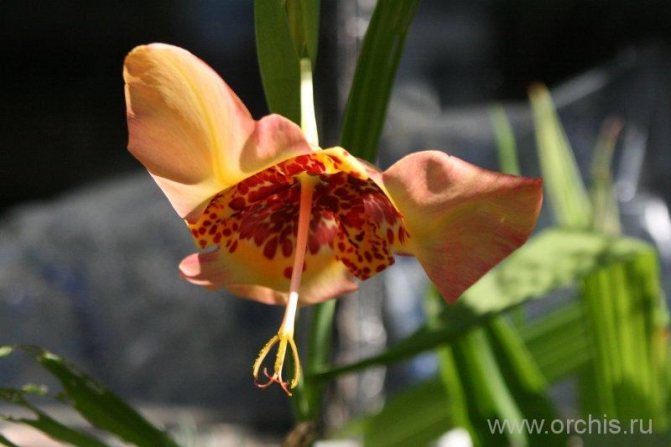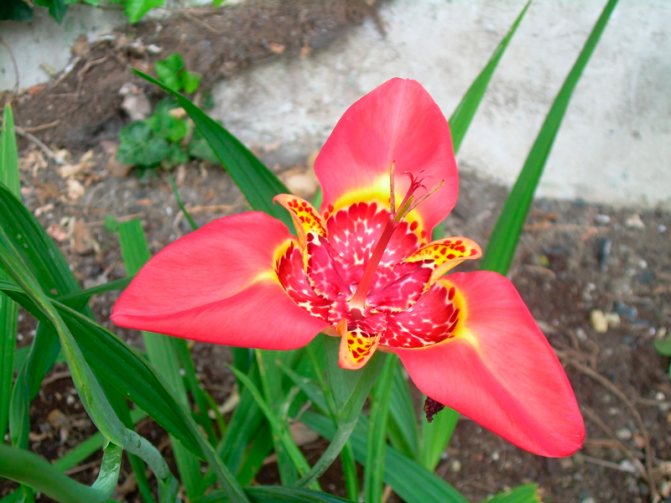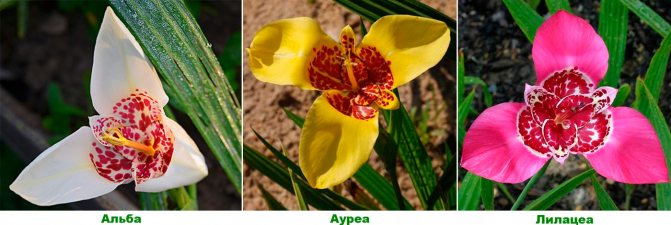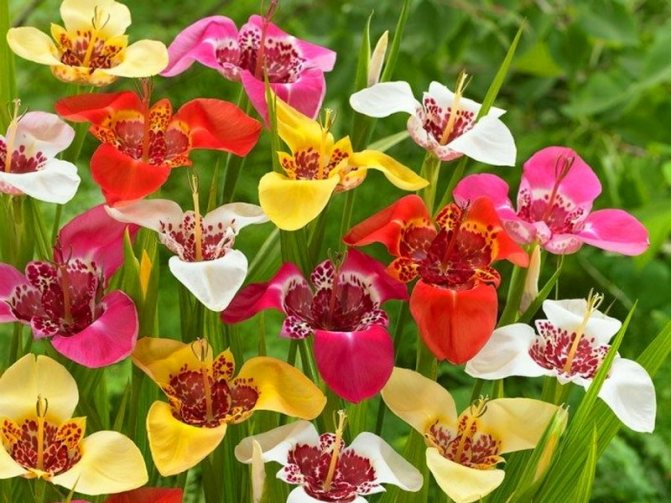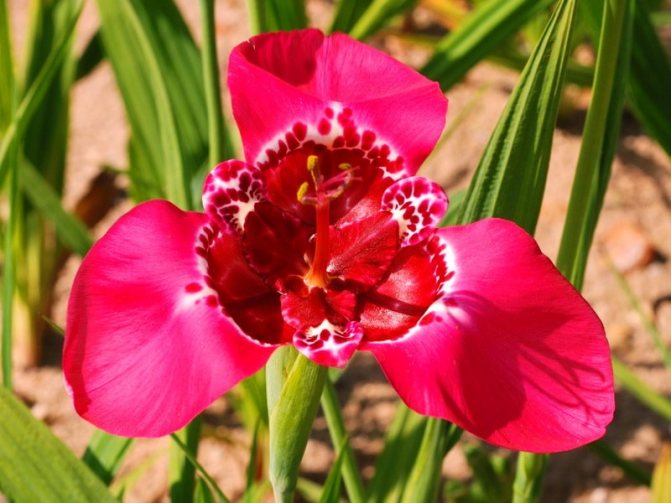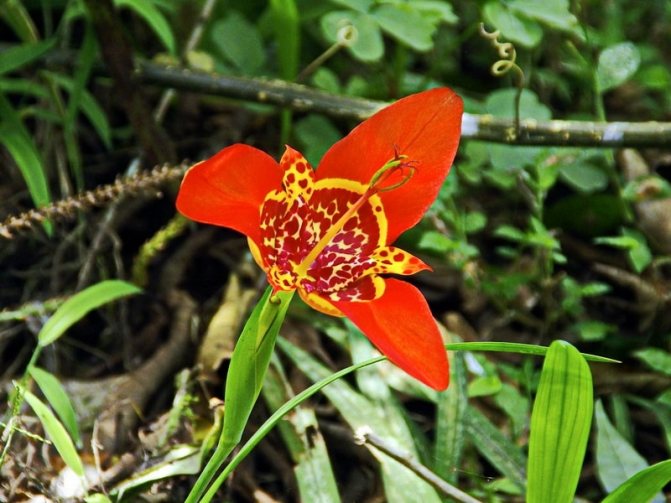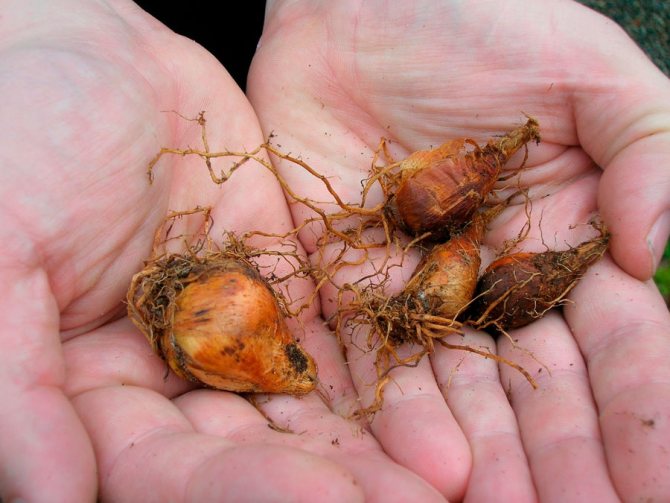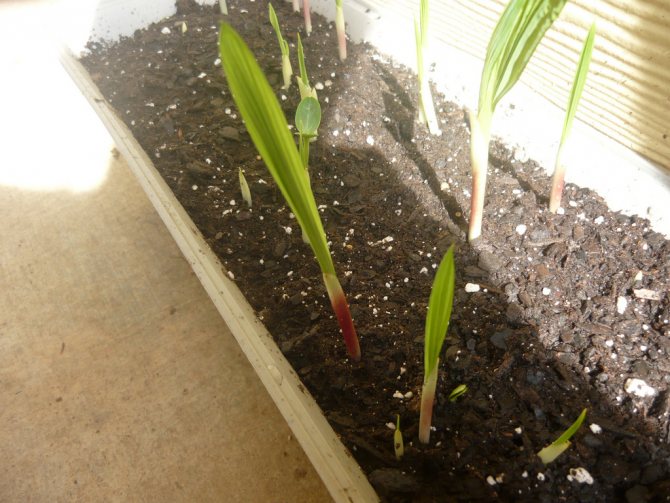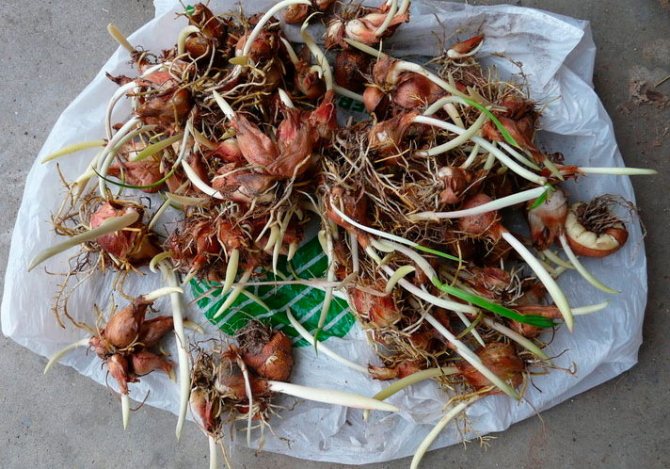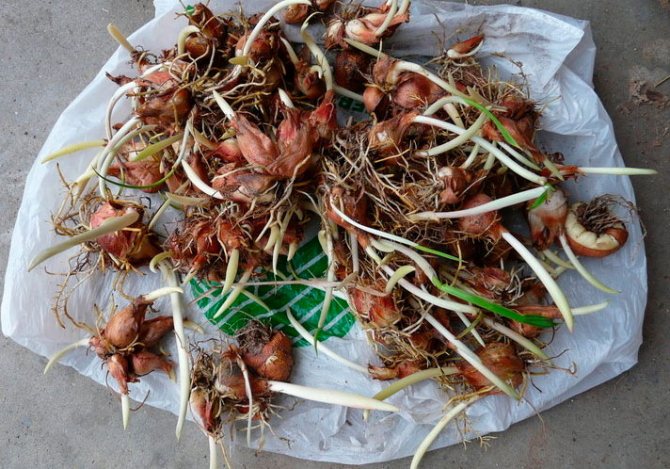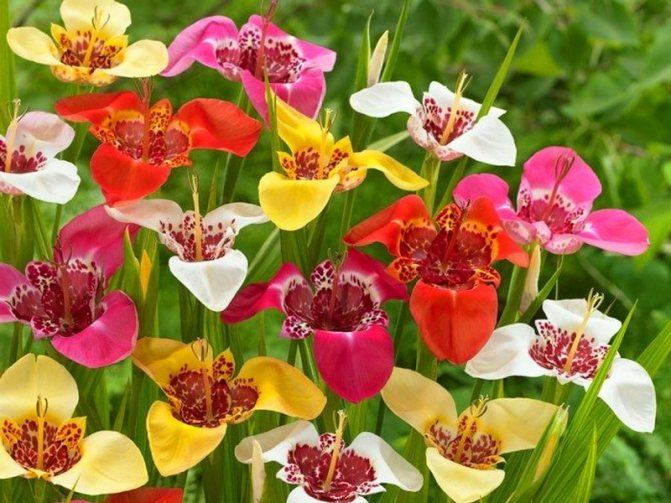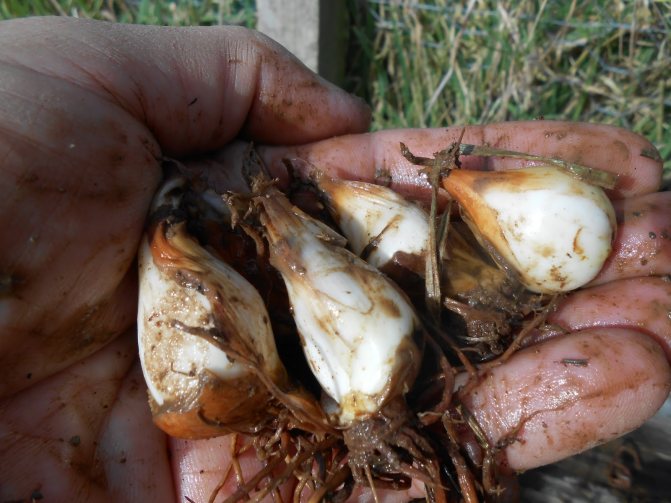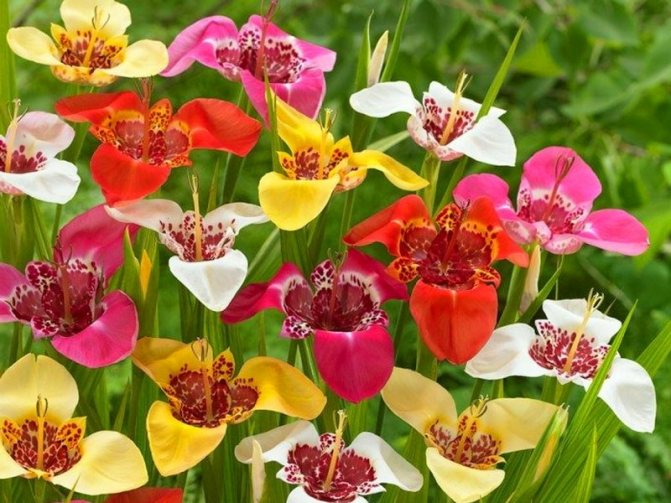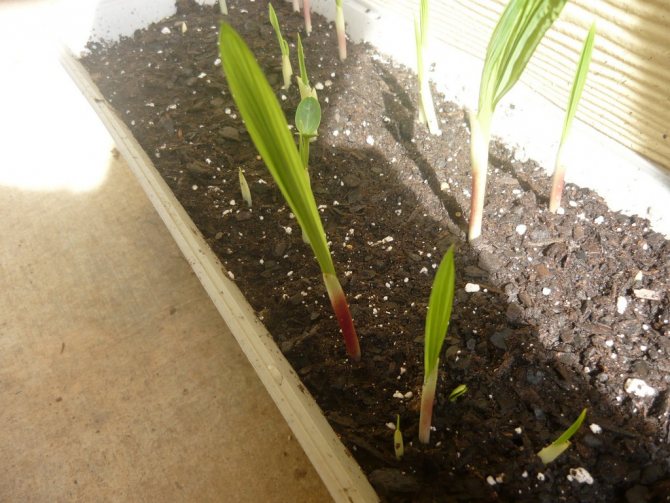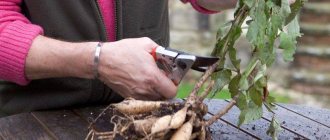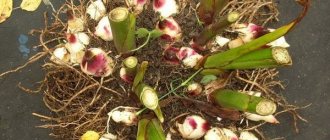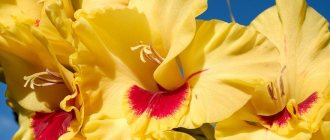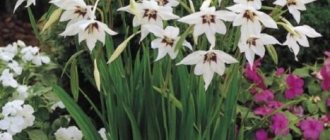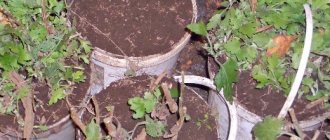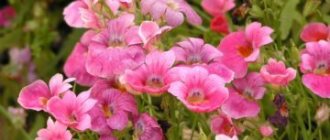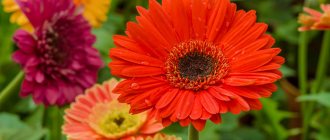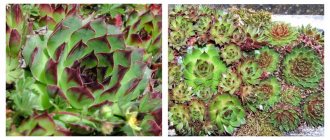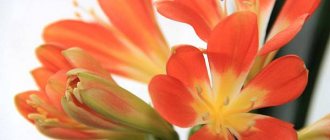A bulbous herbaceous perennial plant, Tigridia, is a member of the Iris family. According to various sources, this genus unites 20–55 species. The range of this culture extends from Mexico in the north to Peru and Chile in the south. The name of this flower is derived from the Latin word tigris (in the genitive case - tigridis), which means "tiger", most likely, this is due to the variegated color of the perianths. Previously, the Aztecs lived on the territory of Mexico, they grew these flowers, because they have medicinal properties. In Europe, tigridia has been cultivated since the 16th century, but it has never been very popular with gardeners, most likely, this is due to the fact that such a plant blooms only in the first half of the day, and the life span of a flower is only 8 hours.
Types and varieties of tigridia
Of all the species of tigridia, only the peacock is cultivated, which appeared in the vastness of Mexico. The corms are covered with membranous scales and grow up to 6 cm longitudinally. Their diameter is usually no more than 4 cm.A number of varieties of peacock tigridia have been bred by gardeners and breeders, but the following are widespread:
| Variety | Flowers |
| Alba | White petals are covered with red spots. |
| Aurea | Carmine ripples are found on the rich yellow bud. |
| Carminea | Spotted orange-yellow representative. |
| Lilacea | Red-lilac petals are decorated with carmine spots. |
| Rosalind | The bud is pink. |
| Canaryensis | Yellow petals frame a bright red heart. |
| Speciosa | The red flower is covered with spots of golden color. |
| Wangutta | Outer petals are spotted, yellow-burgundy in color. |
| Chess | The color looks like a chessboard. |
| Multi-flowered | Gold patterns adorn the burgundy petal background. |

Peacock tigridia and its varieties (with photo)
Despite the fact that there are about 50 species of tigridia in the world, only a few of them are grown in Russia.
Peacock tigridia (Tigridia pavonia) - the most popular type of tigridia due to its beauty, on the basis of which many bright, spectacular varieties have been created.
Perennial herb with small corms of irregular shape, 4 cm in diameter, 5 cm long, covered with membranous scales. One corm, with good care, gives 3 - 5 peduncles per season. Stem 30 - 70 cm high. Leaves are broadly obvious, light green, folded. From 1 to 5 flowers are formed at the top of the peduncle. The color of the petals is bright red, yellow, orange, white, purple with dense spots and dots. The flowers are large, up to 15 cm in diameter and more, without aroma. Flowering occurs in mid-summer and lasts for 20 days. The buds open alternately. The lifespan of each of them is about 10 hours.
Forms and varieties of peacock tigridia:
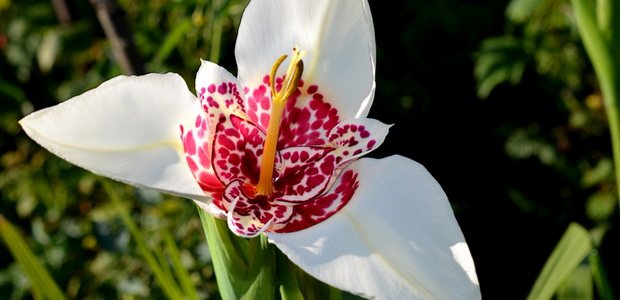

"Alba" - the flowers are white with large and small red spots on the surface;


"Rosalind" - the plant has pale pink inflorescences. There are many small spots in the central part of the flower;
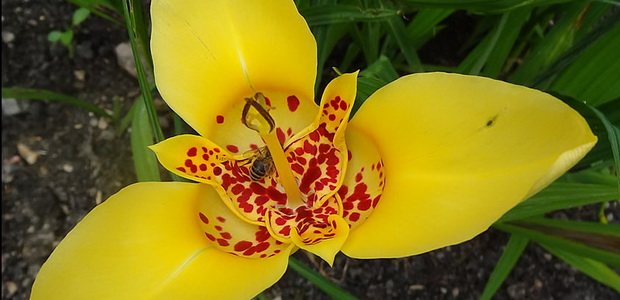

"Aurea" - dark yellow petals with carmine spots on the surface;
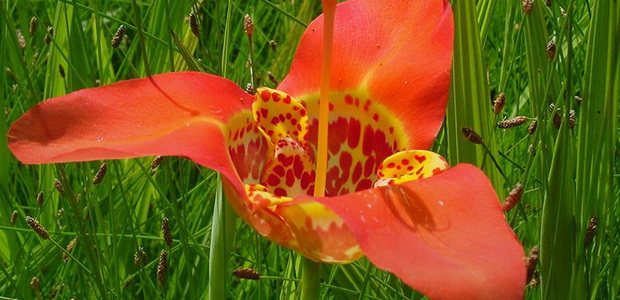

"Speciosa" - scarlet-red buds with yellow spots on the surface;
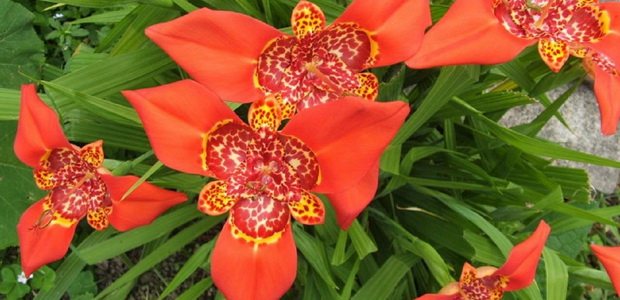

"Carminea" - a variety with rich orange flowers, in the center of which there are many yellow spots;
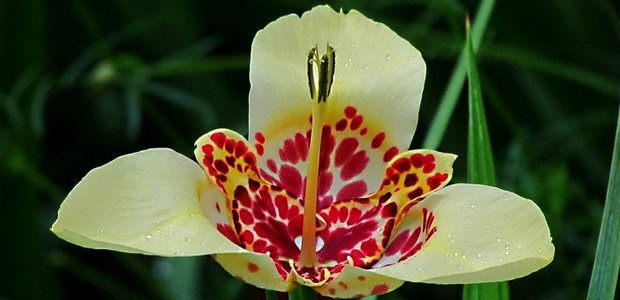

"Canaryensis" - yellow flowers with a spotted red central part;


"Lilacea" - crimson flowers with carmine spots in the center.


A varietal mixture of tigridia peacock is quite popular. "Ferraria mix", which is a compact bush 60 cm high. The leaf plates are belt-shaped, rich green. Flowers with a diameter of 10 - 15 cm. Outer petals of a solid pink, purple, red, orange, yellow shade. There are crimson spots on the inner petals.
How the varieties of peacock tigridia, varied in their color range and height, look like, is shown in the following photos:
Planting tigridia in open ground
When planting an exotic plant, it is important to observe a number of factors and conditions that directly affect the rate of growth and development of a flower. So, if at least one is not fulfilled, the plant runs the risk of not blooming at all, being frail and regularly exposed to diseases or attacks of insect pests.
Landing dates
A perennial does not tolerate frost well, therefore, it is better to plant it in open ground in already established warm weather. In our latitudes, its onset falls at the end of the spring period, or the beginning of the summer.
Pick-up location
The most important factor when planting a flower is its location, and since the culture is very sun-loving, a well-lit area is better for it. You can also consider partial shade, it will not have a detrimental effect on the size of the buds and their color saturation, but it will affect the stems and peduncles. They will need support as they grow very thin. To prevent wind and draft from damaging the tigrid, it is necessary to choose a sufficiently protected place for it.
It neighbors well with the following annuals: gypsophila and lobularia.
Priming
The flower needs loose, moist and drainage soil. With an excessive density of the earth, sawdust, sand should be added to the site. On the eve of planting, it is necessary to dig up the soil and apply fertilizers, for example, mineral, manure, compost. To neutralize the acidity of the soil, lime must be added.
Landing rules
For the prevention of diseases such as fusarium and others, it is necessary to soak the tubers in a fungicide solution diluted in the ratio indicated on the package.
The depth of the bulb depends on the size of the bulb, for example, the largest ones are immersed by 10 cm in the soil, and the smallest ones - by 5 cm.At the same time, the distance between the bulbs should be 15 cm, and the distance between the rows is 20 cm.Already after 4-6 weeks, the first shoots will appear, which will bloom at the end of summer. They will not have time to bloom completely before frost, therefore, tigirdias should be grown in the house before planting in open ground.
Tigridia: planting and care
Landing rules
The flower culture prefers loose, with a neutral level of acidity, soils. It is recommended to plant a plant in nests, 4-5 pieces each, after removing damaged, dry and with obvious signs of disease. For full growth and flowering, certain requirements must be met:
- area with sufficient sunlight;
- loose fertile soil;
- lack of drafts.
Reference! To improve the structure of the soil and the quality of drainage, it is necessary to add sawdust, peat or humus to the soil.
Flowers are planted with bulbs and sown with seeds. Considering that the culture is quite thermophilic, work begins with the onset of warm weather, when the soil warms up to 8-10 degrees, not earlier than late spring - early summer. Planting tigridia in open ground with seeds is usually carried out in seedlings. To do this, it is necessary to sow seeds in a nutritious soil mixture of sand, peat and sod land in advance, even in winter.Do not over-feed the seedlings so that the sprouts do not stretch out. In May - June, the matured seedlings are moved to a permanent place.
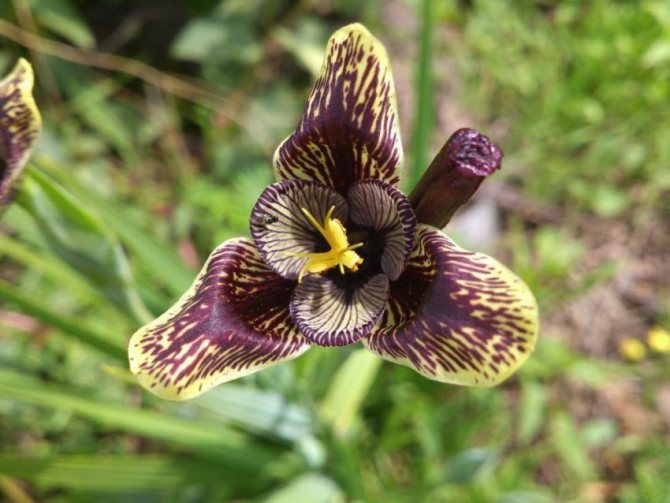

Advice! It is advisable to tie up elongated plants so that the stems do not break off as a result of bad weather.
The bulbs are planted in open ground, depending on the regional characteristics, from the end of April to June. You must first prepare seed material. The bulbs are soaked in a solution with a growth stimulant and a drug for the prevention of diseases. When boarding, certain requirements must be observed.
- Bury the bulbs in the soil, depending on their size. Small ones - by 5 cm, larger ones up to 10 cm deep.
- The rows are placed at a distance of at least 15-20 cm.
- The distance between plants should not be less than 15 cm.
- After planting, cover the soil surface to retain moisture.
To accelerate growth, the bulbs are placed in a warm place for forcing. To do this, they are placed in shallow containers with a peat-sand mixture and watered regularly. It is recommended to provide for the presence of drainage holes so that excess moisture does not accumulate and does not provoke the decay process.
Advice! Placing plants in open ground, you must first take care of the drainage layer in the pits for planting. For this, small crushed stone, broken brick is used.
In the northern regions, the potting method is practiced.
- Bulb nests are placed in pots at least 15 cm high with a fertile soil composition.
- After the appearance of the first shoots, the flower is fed with mineral fertilizer.
- They are planted together with the pot in the ground after the onset of stable warm weather, when the threat of frost has passed.
- As additional heating, a mixture of horse manure and leaves is placed on the bottom of the pit.


Before frosts, in autumn, the pots are brought into a warm room with additional lighting and watering is continued for another 1-2 months, until the bulbous nest is fully ripe. You can store them directly in pots, after cutting off the green mass, placing them in a cellar or on a warmed loggia for the winter.
If the flowers have bloomed in mid-summer, the seeds have time to ripen completely. They are collected and dried together with the seed capsule. The seeds are used to produce seedlings. To do this, they are pretreated with potassium permanganate and a growth stimulant and sown in boxes or special containers in greenhouses, hotbeds, or simply on window sills. The land should be loose and fertile. Seedlings must be hardened before planting in the ground. To do this, lower the temperature or take it out for the day on the street or on an unheated balcony.
Care and watering rules
When growing tigridia, it is necessary to regularly water the area, calculating the volume of water so that the soil gets wet to the depth of the rhizomes. In hot weather, daily watering is recommended. Water splashing on foliage and flowers can cause burns.
Top dressing is carried out twice during the growing season: after the plants sprout and during the period of bud formation. Use complex mineral fertilizers effectively. Weakened flowers are additionally fed with nitroammophos.
Advice! To keep the bulbs large, it is recommended to remove the wilted flowers from the stem to prevent pod formation.
In the care of tigridia in the fall, there are only 2 requirements: limiting watering and removing the aerial part after flowering. This must be done in a timely manner, before the onset of frost.
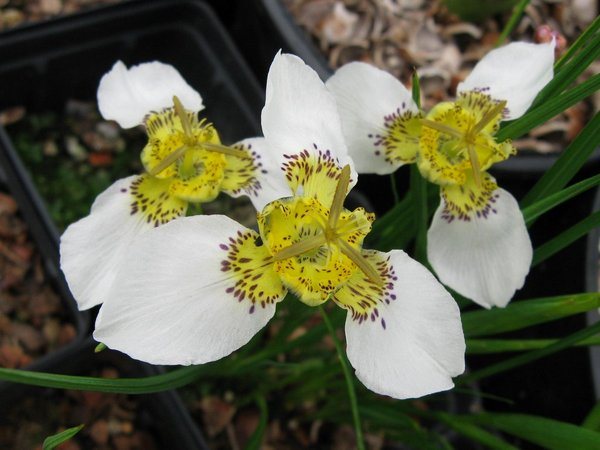

Advice! To get high-quality and large seeds, the capsules are removed, leaving only the largest ones, no more than 2-3 on the stem.
No additional agrotechnical work is required. In the area with flowers, it is necessary to periodically remove weeds, monitor the condition of the plants.Mulching will protect the soil from drying out and sunlight.
Caring for tigridia in the garden
Cultivation includes a set of measures for caring for a perennial, in particular, such as watering, feeding, mulching and pruning. The plant lends itself well to cultivation, if you properly engage in its agricultural technology.
Watering
The plant needs abundant and regular watering, while eliminating stagnation of moisture in the soil. If there is no rain, then moisten the soil every day and additionally spray the plant in the evenings. With excessive watering, the roots will rot quickly, so it should be accurately dosed, all the water should be completely absorbed and not remain on the surface of the earth.
Top dressing
Fertile soil does not need additional feeding, but the poor need it. The first mineral fertilizers should be applied no earlier than 3-4 weeks after the planting of the tigridia. When the buds begin to form, the plant can again be fertilized not only by fertilizing, but also by spraying the foliage with the necessary solution.


Additional work (loosening, mulching, pruning)
The place where tigridia grow should be timely rid of weeds, because they not only violate the aesthetics of flowers, but also provoke the appearance of all sorts of pests.
In order for moisture not to stagnate, but to penetrate into the soil faster, it is necessary to loosen the soil around the tigridia after each watering. Organic mulching will slow down the evaporation of water and prevent the appearance of weeds.
Pruning
Pruning is carried out only after the tigridia has faded, when all the buds are withered. In this way, you can preserve the health and energy of the bulbs before winter.
Tigridia transplant
If you grow the bulbs at home in early spring, the young plants will bloom a little earlier in the open field. To do this, plant them in the fifth week of spring in a container with a special mixture.
One small pot will fit about 4 bulbs, which should be deepened 3 cm into the ground. Then provide them with regular hydration. As the plant grows, it is necessary to increase the amount of watering, based on the fact that the soil must be moistened throughout the depth at which the bulbs are located.
Pots with large drainage holes and a high stand for watering from below are great for replanting. With the appearance of arrows, it is worth placing the plant on a well-lit windowsill. Tigridia should be planted outdoors in early summer.
Planting tigridia bulbs for distillation (with photo)
Gardeners looking for early bloom of tigridia prepare the bulbs for planting in early March. They are placed in medium-sized pots with drainage holes, filled with a loose, nutritious substrate, deepening by 3 cm. After planting, moderate watering is performed as the soil dries. When sprouts appear, the volume of irrigation is increased, but make sure that moisture in the soil does not stagnate, as this will lead to rotting of young plants. It is advisable to use the sump irrigation method.
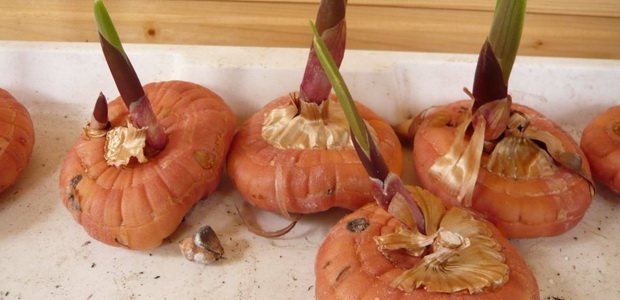

When the arrows appear on the bulbs, they are placed on the windowsill on the south side and grown like this before planting on the site. Planting of planting material in open ground is carried out in the first decade of June. Before planting, holes are prepared with a depth of 6 cm, a layer of drainage with a thickness of about 3 cm is laid on the bottom, then a layer of loose substrate of the same thickness, and only after that a sprouted onion is placed and the hole is covered with soil. The planted bulbs are watered abundantly, then irrigated as the soil dries up.
Diseases and pests
An exotic plant is often attacked by insect pests, and it is also susceptible to a number of dangerous diseases. You can cope with all this with various drugs and preventive measures.
| Problem | Remedy |
| Rotting caused by insufficient maturation of the bulb. | If you collect for storage after the spontaneous withering away of the ground part of the plant, then the problem will not arise. For preventive purposes, the bulbs must be soaked in solutions of fungicides such as Fundazol or Benlate. |
| Rust, scab | Timely treatment with fungicides or herbal infusions. |
| Mosaic | The virus cannot be cured, so it is not possible to save the infected flower. Adequate care will greatly reduce the risk of contracting the disease. |
| Scoops, caterpillars, thrips | Treatment with insecticidal preparations. |
| Slugs | Hand picking only. It can be simplified by using different materials to create the shade in which the insect pests will hide. |
| Medvedki | Destroyed by hand, their moves can be filled with a mixture of soap and water. This measure will either destroy the inhabitants of the minks, or force them to crawl out. |
Reproduction
Tigridia is easy to propagate vegetatively - up to 5 new ones are formed in place of each bulb. Suitable for obtaining adult plants and children. If the seeds are ripe, they can be sown. This method is especially good for flower growers in the northern regions, where it is difficult to get ripe bulbs.
Seeding Algorithm:
- time - the second decade of February;
- the capacity is desirable, individual for each seed, small in size;
- substrate - 1 part of sand and peat, 2 parts of land obtained after rotting turf or ready-made soil for bulbous plants;
- disinfection in vodka - five minutes is enough;
- the seeds are slightly sprinkled with soil - the thickness of its layer is no more than 3 mm;
- conditions of detention - warm (25 degrees), full lighting, regular watering, separated and warm water.
As soon as shoots have appeared, they moisten the soil less often. It is possible to move small tigridia to a flower bed with the establishment of warm weather. Immediately after planting, they need feeding and watering.
Tigridia in winter
Tigridia does not have sufficient frost resistance to overwinter in the middle lane, so it must be dug up in the autumn. The air temperature in the storage room should not fall below zero, however, it is not recommended and too warm, above +10 ° C. It is important that the bulbs are already ripe. If there is a possibility that the ground part of the tigridia will not have time to completely fade before frost, then it is worth resorting to the following measures:
- Remove the corms from the soil without damaging the roots, keeping the earthen lump;
- Keep in a warm, light room until the foliage withers completely.
Then you need to prepare the bulbs for storage, for this you should:
- Peel the tubers;
- Wash;
- Soak in fungicide solution;
- Dry completely.
All this time, small bulbs should not be separated from the parent tubers; it is better to do this in the spring, just before planting.
Preparing for winter, storing bulbs
The quality of their flowering next year depends on how well the tigridia bulbs ripen. Warm weather is often not enough for this. Florists help plants to extend the growing season in the following ways:
- covering the flower bed with covering material;
- transplanted into pots and brought into rooms, the same is done with tigridia, which spent the whole summer in a container.
Bulbs begin to prepare for winter in the last days of September:
- dig out, slightly shaking off the ground, pruning the stems and leaves; dried in the room for at least a month;
- finally shake off the remnants of the earth only a week after the start of drying, then you can cut off the roots and the remaining leaves - a small stump must be left;
- treated with a solution of fungicide for bulbous, diluted according to the instructions;
- dry for another 2-3 weeks.
Important! The nest of bulbs is dried without dividing, this is done in the spring before planting.
The winter storage method depends on the humidity in the room.Where it is dry, you can sprinkle the bulb nests with sand. In damp rooms, it is better to hang them by placing them in a mesh with small holes or a nylon stocking. The optimum storage temperature is 4 to 6 degrees.
Before planting, the nest is carefully divided into separate bulbs and the break points are allowed to dry out.
Mr. Dachnik advises: how to store tigridia bulbs
The bulbs should be covered with sand or peat, then left with the standard humidity and low air temperature. A paper bag is great as a storage container. Periodically it is necessary to check the appearance of the bulbs in order to timely detect possible rot and other defects. All diseased or dry bulbs should be thrown away.


A spectacular foreigner from America, reminiscent of a bright butterfly, will certainly update any garden, loggia, lawn, ephedra, flower bed, pond or even a lonely stone, adding a motley twist and an unusually attractive appearance. The incredible tigridia is the perfect decoration for any garden. Flowers in the open field perfectly tolerate even the most unfavorable climatic conditions. Planting and care should be carried out in strict accordance with the requirements of the plant's agricultural technology. All about it and even more can be found in the proposed article. You can also see the tigridia flowers in the photo, showing the perfect beauty of the plant: Back to the flowers. His name comes from the Latin word "tigris" - "tiger" and "eidos" - "similar" and this is due to the colorful pattern. The exquisite plant belongs to the Iris family. There are about 40 different flower species found in Mexico, Bolivia, Ecuador, Guatemala, and Peru. Despite all the diversity, they still have common features: it is a perennial bulbous plant with a straight or branching stem of 30 -70 cm, flowers are single or 2-3 at the top of the peduncle, the leaves are xiphoid. Because of this peculiarity, you can sometimes see a light in the shape of a square. It has 6 petals: three inner and three large outer petals. Internally, the ending of large petals and small ones have a marble pattern. The perianth consists of 6 lobes: three large and three external. Seeds are compressed, angular. Growing and caring for tigridia is common in the open field. These are always bright flowers. The peacock tigridia stands out especially. Already from the name it is clear that if the association is with a peacock, then the colors are unusually colorful and memorable.
Features of tigridia


The height of the tigridia bush can vary from 0.3 to 0.7 m. This perennial bulbous plant can have branched or simple shoots. Evenly folded greenish leaf plates have a xiphoid shape. At the tops of the arrows, single flowers are located, and they can also be collected in 2 or 3 pieces. The flowers have a bizarre shape, similar to an exotic butterfly. The fruit is a capsule with squeezed, angular seeds inside.
Different varieties - different shades (with photo)
Different varieties can have different shades: red, orange, pink, purple, yellow, white. The flowers are decorated with a cup-shaped core in a speck or strip with a diameter of up to 6 cm. Different varieties of tigridia make it possible to make unusual compositions in the open field. Look at the photo some of them: It is not enough to plant - you need to know and care for the radiant tigrid
At first glance, this extravagant flower with a spectacular appearance may seem like a finicky one. However, further care for tigridia is surprisingly simple. The plant is often planted in groups. It is not enough to properly plant this mysterious guest. You need to know a lot about caring for a radiant tigrid in the open field in your garden. Any gardener knows that this "beast" lasts only one day, or to be more precise - 8 hours.But when the buds of several plants bloom in turn, the effect is so overwhelming that it's worth it. Taking care of a flower is quite simple:
- Water with warm, settled water without a large amount of salt impurities;
- Loosen the soil and subsequently mulch it in order to preserve moisture and internal microclimate;
- Fertilize with complex mineral and organic compounds, mainly in liquid form in bark application;
- Prune to form a beautiful plant;
- Protect from drafts - small garden molds can be used for this;
- Preparing for winter.
It's simple. The only feature is that if it is a hot dry summer, then you need to water more abundantly, and if on the contrary, then as the top layer of the soil dries up. By the way, an experienced florist noticed a similarity with the agricultural technique of growing gladioli. And it really is the same. After planting, a month after the appearance of the leaves, it is necessary to fertilize with mineral fertilizers. The next one is at the time the buds appear. By the end of their flowering, watering must be reduced. This is necessary to prepare for winter. And do not forget to cut the inflorescences. This should be done as the inflorescence wilts, which will help extend the flowering time, and, at the same time, will retain a neat and decorative look. This period usually lasts from July to September. When the aboveground part of the bulbous perennial withers, then it is not worth watering it. Attention! As soon as the first frost occurs, the bulbs need to be dug up.
How to grow tigridia from bulbs and seeds
The exotic perennial is propagated by seeds and corms.
Reproduction of tigridia by seeds implies the preliminary cultivation of seedlings at home. Seeds are planted in containers filled with a nutrient mixture at the end of February - early March. Seedlings are grown at a temperature of 20 - 25 degrees.


Before planting the seeds of tigridia in the soil, the seed is kept in a solution of potassium permanganate for 2 hours. Sowing substrate can be purchased at the store or you can make your own mixture of peat and sand. Within 2 to 3 weeks, sprouts will appear in favorable conditions. When they grow up, they are planted in separate pots and wait until the young plants gain strength and get stronger well. Transplanting into open ground is carried out at the end of May, performing this work by the transfer method together with an earthen lump. This will prevent damage to the fragile root system of the tigridia. Flowering after planting seedlings on the site can be expected in 6 months.


This culture is propagated by corms and children, which are separated from the mother plant when digging a bush. They are carefully detached from the adult bulb with a sharp, clean knife, after which the cut points are treated with charcoal. For prophylaxis against diseases and fungal infections, the planting material is placed in a disinfecting solution for 1 - 2 hours.
Before planting, holes are made on the site, the depth of which will directly depend on the size of the bulb. So, for example, for a small onion, the hole should be about 5 cm deep, for a large one - 10 cm. Planting is done when the soil warms up properly, and warm weather sets in the street with a temperature of at least 18 degrees. The distance between plantings should be 20-30 cm so that the plants do not interfere with each other.
To better understand how tigridia bulbs are planted, look at the photo, which shows all the stages of this work:
Getting ready to get through the winter properly
The southern perennial is thermophilic, so it needs to be helped to survive the winter outside the open ground. As soon as the first frost occurs, the bulbs must be immediately dug up and dried at room temperature. After a month, remove the earth from them so as not to damage the root. We are preparing to survive the winter correctly in advance, and for this we use the methods recommended below.And then there are three types of storage:
- in paper bags on the bottom shelf of the refrigerator,
- in a box of sand,
- hanging in a nylon mesh.
Wherever the tubers are stored, the temperature should be kept from +4 to +10 degrees. You should also pay attention that there is no dampness, humidity in the room and there is good ventilation. As the tigridia is planted, so it will grow
Properly prepared soil is the key to success. Experienced flower growers say that as the tigridia is planted, it will grow in the future, the splendor of budding and flowering depends on it. Therefore, before planting South American beauty, we will prepare the soil. If the ground is heavy, a little fertilizer or sand may be needed. This will help retain moisture and conduct air faster. If the soil is dense, you need to loosen it by adding a little sawdust there. And if the soil is acidic, a solution with the addition of lime will help. If this is a flower bed or growing seedlings at home, then you can easily use the land bought in a flower shop, peat, cultivated sod land or a little sand.
Care
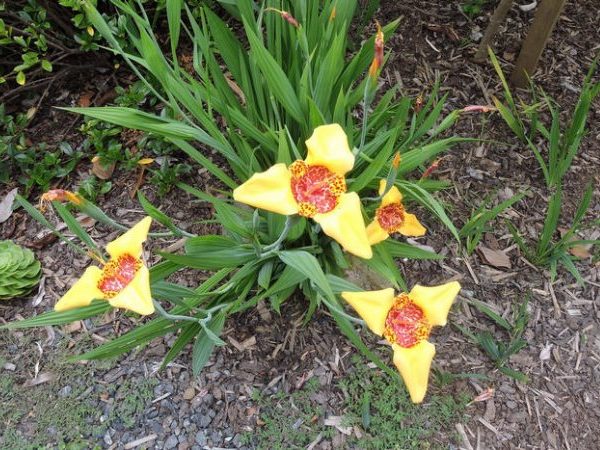

The care measures for tigridia are the same as for other flowers, but with some peculiarities.
Watering
Improper watering of bulbous plants can result in fungal diseases. With constant stagnation of water, the roots do not breathe, and the corm can simply rot. Water the tigridia with warm, settled water. The watering regime for plants at different stages of the growing season is different: in a pot before the emergence of seedlings, watering is moderate, then frequent, it is also watered when planting in open ground. In hot weather, so much water is poured under the plants to completely wet the entire root layer.
After watering, loosening is carried out so that the air flows well to the roots. Mulching - with crushed bark, humus, peat, but only well-aged, will help to preserve moisture and keep the soil in a loose state.
Important! When watering, water should not come into contact with leaves or flowers.
After the last flower withers, watering should be gradually reduced.
Top dressing
Tigridia is not fed with organics. Mineral fertilizers are applied regularly, always in liquid form. For successful growth and flowering, use the following feeding schedule:
- when the first leaves appear, dilute in 10 liters of water st. spoon of urea and st. a spoonful of potassium sulfate (chloride acidifies the soil more strongly), this amount is enough for feeding 1 sq. m landings;
- a month later - the second feeding: for 10 liters of water, you need to add 15 g of urea, 10 g of potassium sulfate and 15 g of superphosphate, the consumption rates are the same;
- when buds appear, each square is watered. m solution of 30 g of superphosphate and 10 g of potassium sulfate and 15 g of urea per 10 liters of water;
- during flowering, 30 g of superphosphate and 10 g of potassium sulfate are dissolved in 10 liters of water, the amount is calculated per 1 sq. m.
Regular feeding of tigridia is the key to its lush flowering. They are combined with soil moisture.
Pruning
In tigridia, all inflorescences that have lost petals are removed. Seeds can only ripen from those flowers that have blossomed in July. It is not advisable to leave more than one flower for these purposes - the plant is greatly weakened. Finally, remove the leaves, leaving a small 2 cm stump when they are completely dry. After drying the corms of tigridia, the roots must also be cut off.
Diseases and pests do not sleep
No specific pests threaten tigridia. However, do not forget about the two worst enemies of almost all colors - frost and rot. You should not relax - diseases and pests do not sleep and are always ready to attack. It's a shame if the plant dies. You can hide it from the frost in the warmth, but what about the rot? And from it there is an excellent remedy - before drying, treat it with fungicides - foundationol or benlate.In addition to these two "friends", the plant can be affected by scab, rust and the mosaic virus. If you carry out the correct preventive measures, properly store, spray the leaves with antifungal agents or herbal infusions, then the flowers are completely safe. Experienced plant breeders advise using a natural mustard solution against the fungus: 10 grams of mustard per 1 liter of water. Natural pests such as thrips, bears, slugs also do not sleep. It is better to deal with them with strong and professional means from the store. The smallest elementary effort and each has a brilliant eye-candy and another achievement as a gardener.
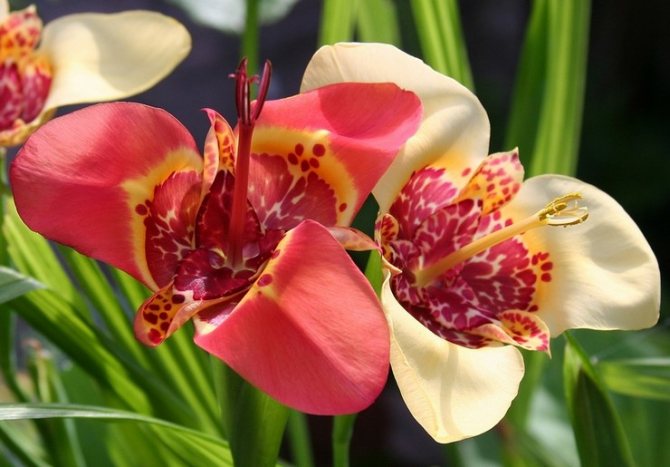

Tigridia (Tigridia) is an unpretentious perennial herbaceous bulbous plant from the Iris family, uniting in its family about fifty different species. The variegated color of its perianth forms the basis of the plant's name, which in Latin means "tiger". A feature of tigridia is the very short flowering period of each flower. He only lives for 8-10 hours.
Description of tigridia and its varieties
The very name of the tigridia flower speaks of its exotic origin. This plant is not very popular with us, but in North America, which is the birthplace of tigridia, it was even eaten before. Due to the fact that the tubers contain a lot of starch, they were a substitute for potatoes for the indigenous people.
The flower got its unusual name because of the spotty color inside the petals. From Latin, tigridia is translated as "like a tiger". The outer petals can be of a wide variety of colors: from white and pale pink to bright red and purple.
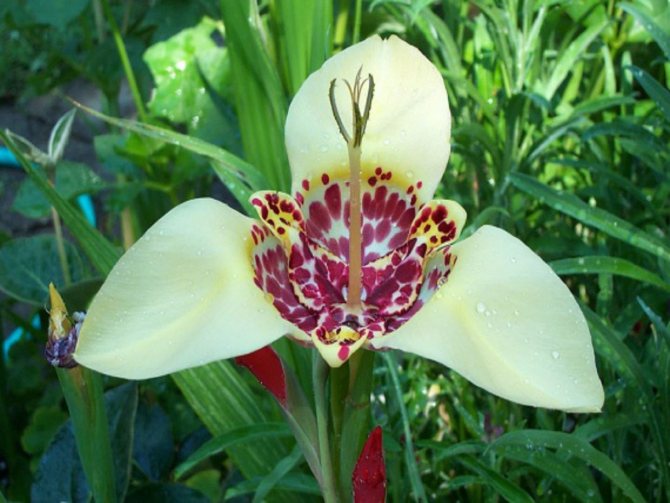

The tigridia reaches a height of no more than 70 centimeters, and the flowers are about 8-10 centimeters in diameter. One bush can have up to five stems, on which from one to three buds appear. You can admire the flowering only for 8 hours, after which the flower will immediately wither.
In total, more than 40 species of exotic plants are known, but for growing in flower beds and flower beds, the following types are used:
- Auer. Large flowers that stand out with bright yellow petals and a deep purple center.
- Alba. White flowers with a red spotted center.
- Lylation. The base is speckled with red, from which lilac petals come out.
- Carminea. The petals are bright orange in color with a yellow base, on which there are many red and purple spots.
For growing in the garden, tigridium mixed is most often chosen, a mixture of different species. Together they look bright and unusual.
Opsyvanie flower tigridia
The tigridium flower grows on average from 30 cm to 70 cm.It consists of a rhizome in the form of a dense corm, a straight or branched stem, xiphoid leaf plates of bright green color, a peduncle with several buds and fruits - boxes with smooth brown seeds. Butterfly flowers consist of three large monochromatic petals of red, pink, yellow, white, lilac or orange and three small petals with multi-colored patterns - stains, consisting of 2-3 shades. In group plantings, tigridia bloom from mid-summer to almost the end of October.
Characteristics of the tigridia plant
Tigridia (Tigridia) is a beautiful exotic perennial corm plant with an erect or branched shoot.


Plant height is 25 - 70 cm. The rhizome is a dense, scaly bulb of irregular shape. One corm produces up to 6 peduncles.


Leaves are formed at the base of the stem in the form of a rosette. When describing a tigridia plant, it is worth noting that its leaf plates are linear, pointed, rough, corrugated, bright green.


On each peduncle, several buds are formed with three large outer and three inner small petals.Due to this arrangement of the petals, the flower has the shape of a triangle. The diameter of the flower is 7 - 10 cm. The outer edges of the petals are solid yellow, orange, red, coral, less often white. In the central part of the flower there are contrasting streaks, spots and dots. Tigridia blooms in July and lasts for 4 weeks.
At the end of flowering, the plant forms a fruit - an oval brown box with angular seeds inside.
In our country, this culture is relatively rare and, due to its unusual external characteristics, is considered exotic.
Planting tigridia in the open field
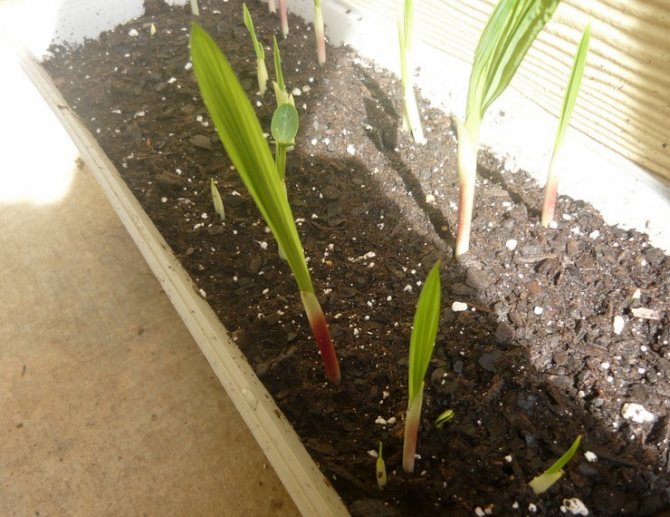

Optimal time for planting tigridia
The most suitable period for planting tigridia is the second half of May or early June. The bulbs are very sensitive to the slightest cold snap, therefore, they should be planted in open ground after the complete cessation of night frosts and severe cold snaps.
In case of insufficient light, the shoots of plants will begin to stretch, become thin and brittle. At the slightest breath of wind, the stem can be damaged. Based on this, it is recommended to choose only an open sunny area for planting tigridia, without the slightest hint of shade or partial shade.
The flower does not tolerate cold wind and drafts. This should also be taken into account when choosing a tigridia planting site.
The soil should be light, loose and very nutritious. The root part must receive a sufficient amount of air and moisture. Good drainage is also needed to keep the water from stagnating. The earth must first be dug up, adding lime in the process of work. If the site consists of clay or loamy soil, then it is recommended to mix it with sawdust, fine gravel or coarse river sand.
How to plant tigridia correctly
You can grow tigridia flowers from seeds in a seedling way. To do this, the seeds are soaked in warm water for 1-2 hours or a weak solution of potassium permanganate, after which they are sown in a sandy peat substrate and kept in greenhouse conditions for 15-20 days. Seedlings are transferred to open ground in the last days of May.
For the bulbs, before planting, preventive measures are taken against possible diseases and infections. They are treated with a special disinfecting solution (for example, 1 liter of water and 2 ml of "Maxim") for two hours. And for earlier flowering, it is recommended to put the bulbs for distillation.
Before planting tigridia bulbs in open ground, you need to sort them. The size of the planting hole depends on the size of the planting material.
It is very important that the planting material is planted in well-heated soil with a temperature of about 20 degrees Celsius. For small tigridia bulbs, the hole depth is about 5 cm, and for large ones - about 10 cm.The distance between plants is 15-20 cm, between rows - 20-30 cm.
Preparing corms for wintering
The South American beauty tigridia is loved by flower growers all over the world. It was grown by the ancient Aztecs. Historical descriptions say that the ancient tribe used tubers for food, and healers treated them for infertility and stomach diseases. However, growing the flower is much easier than keeping it during the cold season.
The bloom of tigridia lasts almost until frost. In cold regions, the flower has to be dug up for storage even with green foliage. At the end of the growing season, several babies begin to grow in the root zone near the uterine bulb. In order for the new planting material, which will be able to germinate in the coming spring, to be viable, it is necessary to properly prepare for storage.
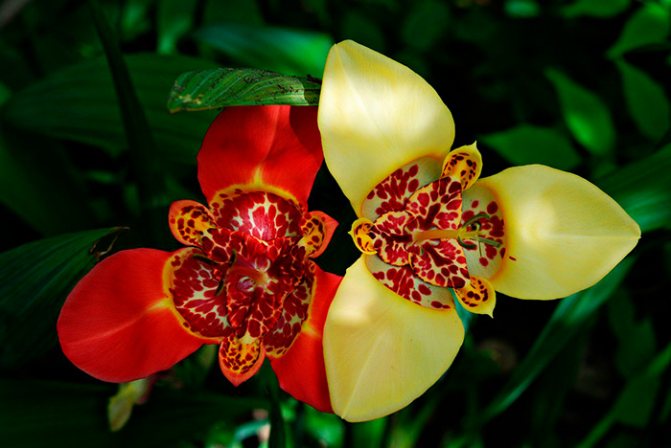

- The nest of the planting bulbs must be dug before the first frost appears, around the end of September. They are dug out with the top of the flower.
- To remove excess moisture, the corms, without dividing the nests, are placed in a well-ventilated room at room temperature for 14 days.
- Dried leaves and parts of the root are separated very carefully, trying not to disturb the corms. After pruning, hemp is left with a length of approximately 3 cm.
- Then the plant must be treated with some effective fungicide. For example, 0.7% foundation emulsion. An excellent remedy for dressing bulbs is a tincture of garlic - 0.5 kg per 1 liter of water.
- After processing, the bulbs are dried again (7-15 days) to remove moisture.
Caring for tigridia in the garden
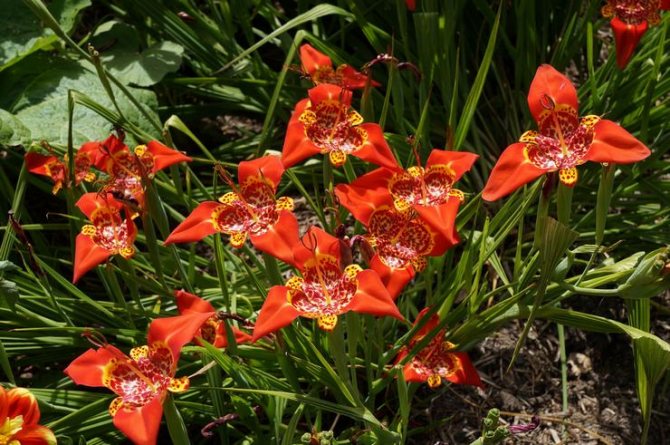

Watering and spraying
Caring for tigridia is not very difficult, even a novice florist will be able to do it. Tigridia have special requirements for watering. Irrigation water should not only moisten the soil surface, but also get to the root system of the plant. It is necessary to water the soil where the tigridia flower is grown regularly in moderate amounts, and on hot summer days - every day in the evening. If there is no natural precipitation for several weeks in a row, and the temperature rises to thirty degrees and above, then it is recommended to add daily spraying with warm water to regular irrigation. Excess and lack of moisture in the soil will lead to the death of flowering tigridia bushes.
Fertilizing
If the cultivation of tigridia takes place in a fertile area or is already fed with the necessary nutrients, then fertilizers no longer need to be applied. Poor or depleted soils, it is advisable to fertilize twice a season. The first time after planting tigridia bulbs is watered with liquid mineral fertilizer in about a month. The second time - when buds begin to form - tigridia plants need not only to be watered at the root, but also to spray the leafy part. The solution is prepared from 3 liters of water and 9 g of complex mineral fertilizer.
Conditions
It is not easy for a plant native to the tropics to take root in northern latitudes. Tigridia does not tolerate not only frost, but also cold air, is afraid of drafts, loves the sun and warmth very much. It is not easy to please this exotic beauty.
Place on the site
Few plants can tolerate direct sunlight throughout the day. Tigridia is just one of them. With this kind of lighting, it will be the most decorative. In a slight shading, the color of the petals fades, and the peduncles are stretched, even a strong wind can break them. In the shade, this flower is incapable of existing.
Advice! For tigridia, a site protected from the wind on all sides is suitable.
The soil
To form a large bulb that can give the maximum number of peduncles, you need a sufficient amount of nutrients. There should be a lot of humus in the soil. But not only. An important condition is loose and lightweight earth, which is well permeable to moisture and air.
Advice! The best soil for tigridia is loam or sandy loam, but without stagnant water.
In moist soil, corms easily rot. It is necessary to control indicators of soil acidity. Tigridia grows well if the pH is close to 7. Acidic soils will have to be limed, and sand and well-aged peat will have to be added to the heavy-textured soil.
Experienced flower growers organize soil heating by placing a layer of a mixture of horse manure and tree leaves at a depth of 30 cm. Its thickness is from 25 to 35 cm. In this case, it is better to plant the corms in pots and dig them into the ground. This method of growing tigridia is especially justified in the north, where the summer is short.
Breeding methods for tigridia


Seed propagation
Usually, the seedling method of reproduction of tigridia is used. Seeds are planted in February - March and germinated at a temperature of about 25 degrees Celsius. Picking at individual containers helps prevent root injuries when transplanting plants.Tigridia seedlings must be transferred to open ground by transshipment (together with an earthen clod). It usually takes six to seven months from sowing the seeds to the first flowering.
Propagation by daughter bulbs
Small baby bulbs must be separated from the adult bulb with a sharp knife on the day of planting. It is recommended to sprinkle the cut points with a powder of charcoal or activated carbon, then immediately place the planting material in the ground, sprinkle it and water it.
Growing features
The plant is probably not very popular due to its short flowering period. If you want to see unusual flowers with your own eyes, you need to create the most comfortable conditions for them. Tigridia actively grows and blooms on light soils, which are not very acidic. It feels good on sandy or loamy soils, if they are pre-enriched with peat, compost and fertilizers.
Narcissus flower: what it looks like, characteristics and description
You can see big beautiful buds if you provide the tigrid with enough sunlight. A plant native to the southern latitudes of North America, which explains his love for the sun. Because of the thin and fragile stems, they choose a place for planting that is protected from gusts of wind and drafts.
Experienced growers recommend planting crops in groups: then the flowers will bloom in turn, and this will create the appearance of continuous flowering. For outdoor cultivation, you can use:
- seeds;
- bulbs.
For growing with seeds, work begins in February - March, sowing them into a container and gently pressing into the ground by 2-3 mm. Small individual seedling pots with a mixture of turf, sand and peat can be used as containers. The first shoots should appear in about three weeks.
In late spring or early summer, plants can be transplanted outdoors. The main thing is to avoid the danger of frost. In the fall, bulbs can be obtained from each young plant, which are used in the future.
It is much easier to grow a flower using its bulbs. Planting in open ground is carried out only after the onset of heat. The most favorable time for this is early June. Small bulbs are placed in the ground to a depth of 5 centimeters. For larger tubers, the depth should be at least 10 centimeters. In order for the flowers to develop well, the distance between them should not be less than 15 centimeters.
Indoor flower euphorbia: care, reproduction, transplant
You can also arrange for the sprouting of the bulbs in advance. To do this, in early April, they are planted in boxes with loose soil and are actively moistened, especially during the first week. Sprouted bulbs are planted outdoors in late spring. This method allows you to significantly speed up the appearance of colors.
Tigridia in winter
Storage of tigridia bulbs
The thermophilic tigridia is not able to withstand the harsh winter times and negative thermometer readings, so its bulbs are removed from the ground in autumn and stored in a room with a low above zero temperature. Only well-ripened bulbs can preserve in good quality. That is why it is very important to remove them from the soil in a timely manner. A withered aerial part of flowering plants is an indicator of an already matured and ready-to-store root part. If the shoots and leaves are still green, and the weather already presents surprises in the form of frost, then it is necessary to immediately dig up the plants along with a clod of earth and bring them in a cool room with good lighting. As soon as the aboveground part fades, you can proceed to the next stage.
All the bulbs, with and without children, are first cleaned and washed well under running water, then soaked in a disinfecting solution (for example, in Fundazole or Maxim) and left to dry. Dry prepared corms can be stored until spring in two ways.
- Wooden boxes or plastic containers are filled with peat or sand, the planting material is buried in them and kept in a cellar or basement. The necessary conditions are moderate humidity and air temperature in the range of 3-10 degrees Celsius.
- You can use paper bags or cardboard boxes to store tigridia bulbs. They are placed on the lower shelf of the refrigerator along with the planting material, not forgetting to inspect their condition from time to time.
Storage features
Proper care during the winter storage period of tigridia is equally important.
- The best wintering places are the cellar and basement. If the number of corms is small, then they can be stored in the refrigerator.
- After processing, the bulbs must be sprinkled with sand or sawdust. It is believed that the best material for storing tigridia is furnace ash. It simultaneously protects the corms from mold and fungal diseases, and also maintains the necessary moisture level during the winter storage period of tigridia.
Advice. In a more humid environment, to ensure adequate ventilation, the corms are placed in a net and then suspended.
- If the tubers are not covered with ash, then during the winter period they must be sorted out several times, rejecting unusable, sick, rotten and dried tubers.
Attention! When sorting the material, it is necessary to pay attention to the turgor or density of the corms. If you notice that they become soft, then it is worth increasing the moisture content of the composition in which they are stored. Otherwise, before the onset of spring, they will dry out and be unviable.
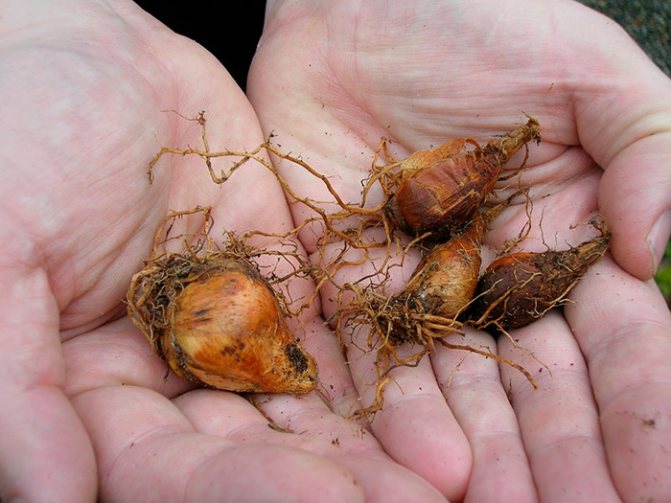

Planting material
- With the onset of spring, before planting, a few days before planting, planting nests are dug out of the sand, separated, and discarded unsuitable material. After waiting for the fracture sites to dry, tigridia bulbs can be planted in the soil or in containers for germination.
Diseases and pests of tigridia
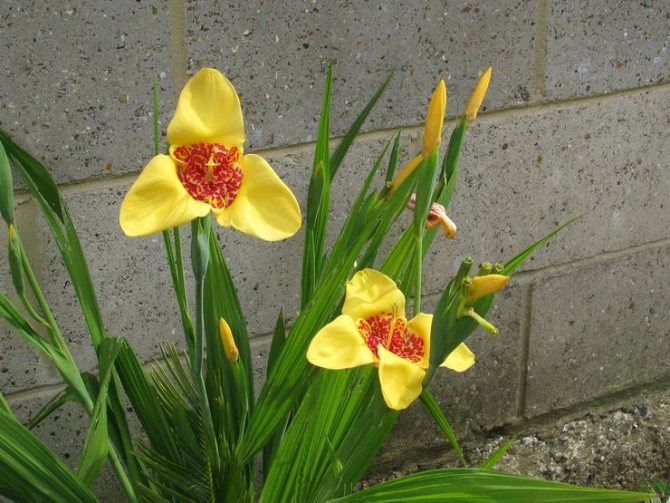

Possible diseases of tigridia are scab, rust, root rot, mosaic.
Preventive treatments of flower plantations with herbal infusions, fungicidal preparations or folk recipes will help prevent the emergence and spread of the disease. Crops must be sprayed repeatedly until buds appear. It is impossible to rid the flowers of the mosaic.
Possible pests of tigridia are slugs, bears, thrips, caterpillars, cabbage scoops.
To kill slugs, you will need various traps installed on a flower garden or manual collection of pests. Bears die from treatment with soapy water. And the rest of the uninvited guests can be destroyed only with the help of insecticides.
Choosing a place for planting tigridia
Tigridia love sunlight. Therefore, it is best to plant them in well-lit areas. However, even in partial shade, tigridia are able to take root - the brightness of the colors from such conditions will suffer slightly, and the plant will develop normally, but the stems of the peduncles will be thinner and weaker. This means that you can hardly do without a garter.
Wind protection also does not hurt. Experienced gardeners advise planting tigridia in secluded corners, areas where there are practically no drafts. Thin long stems are rather fragile. Harsh gusts of wind can damage them. But, again, you can give the peduncles stability by tying them to the pegs.
Loose and lightweight soil is suitable for tigridia. Like all bulbous plants, this plant does not tolerate excessive soil moisture levels. Therefore, it is recommended to loosen a dense layer of soil by adding a little sawdust or sand to it.
Types and varieties of tigridia with a photo
Peacock tigridia (Tigridia pavonia)
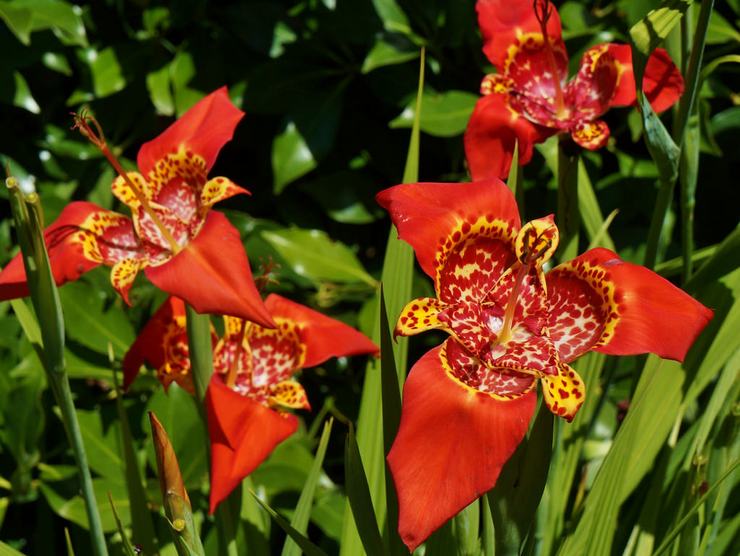

The most common species, most often found in our country. The flowering period lasts 2-3 weeks and usually begins in the second half of July. The average height is from 30 cm to 70 cm. It blooms in purple, orange, red and yellow shades. Varieties:
Tigridium tubular (Tigridia buccifera)


A compact form of a flower with rounded outer petals of a lilac shade, up to 7 cm in diameter. The stem is short, branching, the leaves are narrow. It is used in group plantings, as well as on a rocky background and near water bodies. The average height is 40-50 cm.
Tigridia multiflora (Tigridia multiflora)
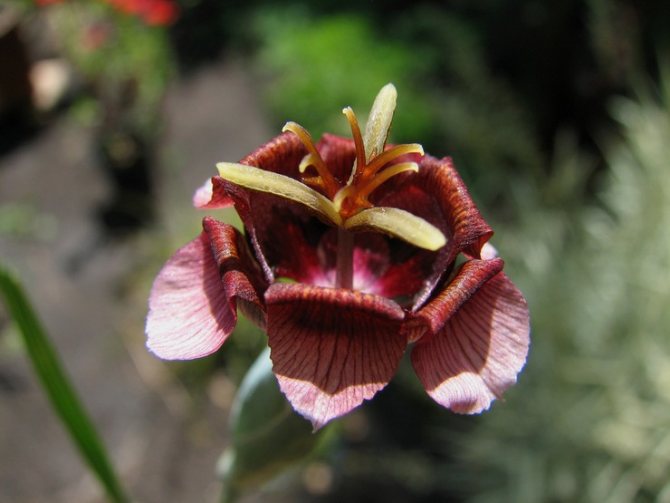

A species with small-sized burgundy and pinkish flowers. The difference from other plants is the large petals bent outward.
Chess Tigridia (Tigridia meleagris)
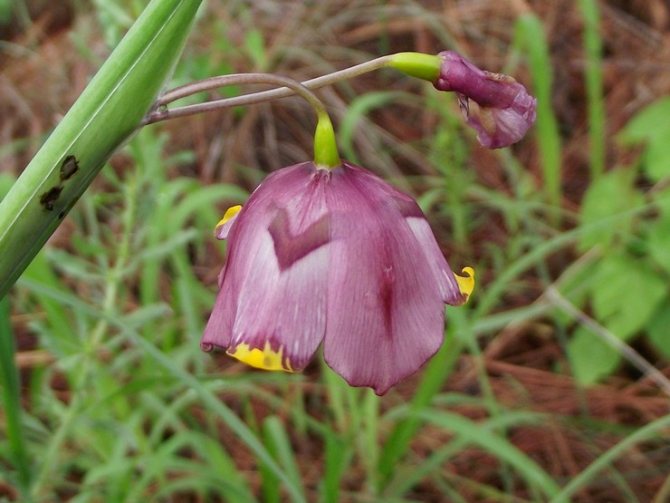

An unusual color appearance of a flower, the surface of which is covered with light and dark spots of different shades in a checkerboard pattern. Hybrid varieties are painted in white and lilac shades.
Breeding work on the development of new varieties of tigridia continues to this day. The work uses such types of flowers as Tubular, Mexican, Celeriana and others. The tigridium flower is also used by professional landscape designers who recommend planting a plant in combination with conifers and ground cover representatives. Thyme, phlox, arabis and stonecrop are excellent neighbors for unusual flowers.
Popular varieties
The flower culture, although unpretentious, is not popular with domestic gardeners. Currently, there are more than fifty varieties of tigridia in the world. Colorful flower arrangements are successfully used by landscape designers. Most varieties grow in hot tropical countries. In our country, several varieties have been adapted and successfully grown:
- "Tigridia peacock";
- Alba;
- Carminea;
- Lilacea;
- Rosalind;
- "Aurea".
Also common varieties of tigridia tubular, checkerboard, multi-flowered. Flowers used to decorate plots and flower beds are planted in groups of one or several varieties at once.
Tigridia are successfully crossed, as a result new inflorescences with exotic and bright colors appear.
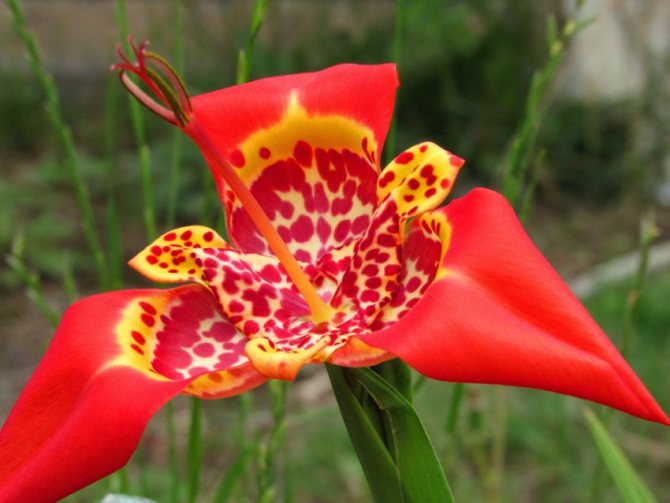

Basic rules of care
Caring for tigridia is not difficult at all. They do not need regular soil loosening and frequent feeding. The surface of the soil near the plants can be covered with a layer of peat or well-rotted leaves and organic residues. Under such mulch, the soil is not compacted, maintaining the porosity of the structure. If the bulbs are planted in well-fertilized beds, it is not necessary to add additional nutrients to the soil. If the soil is depleted, then it is enough to carry out two dressings. The first - a month after the appearance of the leaves. For germinated bulbs - two weeks after planting in the ground. The second feeding should be timed to the moment the buds appear. It is best to use mineral complexes as fertilizers (3 g per liter of water). Proper watering is very important for the normal development of tigridia. Surface irrigation is unacceptable. The water should soak the soil well so that the bulb gets the moisture it needs. The regularity of watering depends on the weather. In dry summer conditions, it is recommended not only to moisten the soil daily, but also to spray the aboveground part of the plants.
Tigridia: combination with other plants
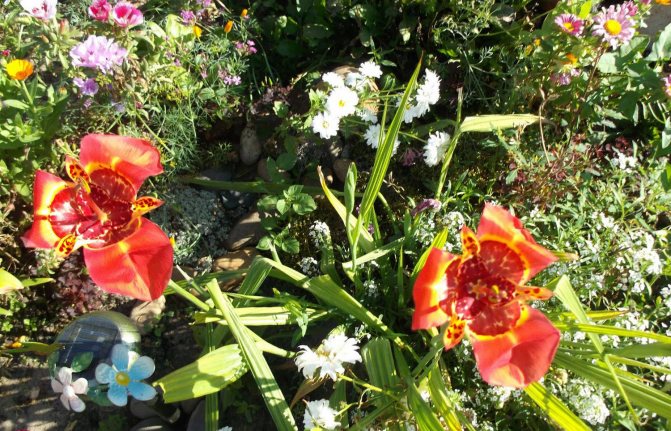

Several types and varieties of tigridia, planted in one flowerbed, look best at once.
Such a bright flower garden will gradually bloom in different colors.
The flower is often combined with other plants.
For example, phlox, arabis or conifers will be great neighbors.
It is not recommended to plant other flowers next to the tigrid, which can shade its beauty.
Tigridia - description and types
A flowering herbaceous perennial with a height of thirty to seventy centimeters has dense corms with rhizomes, branching or erect stems, evenly folded, light green, xiphoid leaves and peduncles with one or more buds growing directly from the ground. Flowers with diameters from eight to ten centimeters consist of several small and three large petals, due to which they have a triangular shape. The central part of the bud is painted with contrasting stains, and the outer monochromatic petals can be pink, white, blue, yellow, red, lilac.
Each tigridia flower blooms for only a few hours, but a new bud opens around it the next day. Therefore, in order to obtain long-term flowering, plants are planted in a flower bed in groups.
Popular types
More than fifty species of tigridia are known, of which only a few are grown in culture:
- Peacock tigridia - plants from twenty-five to seventy centimeters in height bloom in the second half of summer for two to three weeks. He has a corm four centimeters wide and six centimeters long, around which several children are formed in one season. The corm itself dries up completely by the end of the season. Peacock tigridia is distinguished by light green xiphoid, wide leaves with longitudinal folds and purple, white, orange, light pink or scarlet flowers with a diameter of ten to fifteen centimeters. Each bush forms from three to five shoots with three to five flowers. Depending on the variety, there may be red, carmine or yellow spots inside the flower.
- Tigridia multiflorous differs in burgundy medium-sized petals bent outward, the base of which has a darker shade.
- Checkerboard tigridia is a plant with flowers of unusual color. Fawn spots are staggered on large light petals of the flower.
- Tigridium tubular has narrow leaves, a short branching stem and rounded outer petals of light pink color. The diameter of each bud is from five to seven centimeters.
Protection from pests and diseases
Although the plant does not cause difficulties in growing, some problems may arise due to violation of agricultural rules. More often they are the result of improper watering, dressing, and inappropriate location.
A common problem is bulb rotting during storage. The reason for this is their insufficient maturation. Therefore, before digging out the bulbs, you need to wait for the ground part of the tigrid to wilted naturally. Before storage, treat the planting material with a fungicide.
In the open field, the plant can become infected:
- tobacco mosaic;
- rust;
- scab.
Tobacco mosaic is a viral disease for which there are no effective drugs. Therefore, the infected bush must be dug up and disposed of. Treat all gardening equipment and planting material with antiseptics.
To combat rust and scab, fungicidal solutions are used:
- Albite;
- Flutrivit;
- Cuproxat.
Pests of tigridia:
- bear;
- thrips;
- cabbage scoop;
- slug.
It is recommended to collect slugs by hand. For prevention, use special chemicals (Mesurol, Glanzit, Snacol). It is very difficult to identify the bear, since they settle in the root system. As a rule, when signs of damage appear on the ground part of the plant, it is no longer possible to save it. Therefore, for the prevention of bears, before planting tubers, it is imperative to pickle with an insecticide (Decis, Confidor). Thrips and scoops can be fought by spraying the plant with chemicals Agrovertin, Actellik and their analogues.
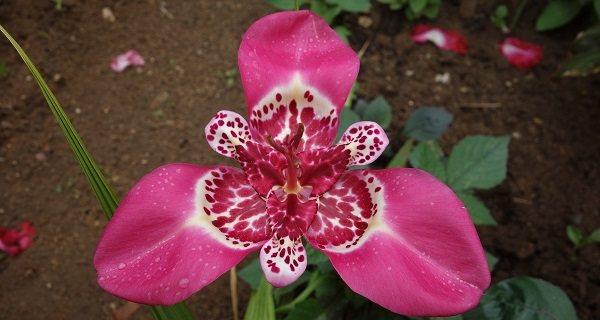

Growing methods in the Moscow region
It is not difficult to grow tigridia in central Russia. It is enough to plant it after the threat of frost has passed.In mid-May, when the ground is already warmed up, the planting material is planted in the ground and spilled.


At the bottom of the hole, you need to put some sand, and the onion is already laid on it. Then it is covered with earth with humus and spilled. At first, in cold weather, the plant takes cover and opens up for airing. You can germinate it in advance at home in a container and then plant it in the ground.
Planting tigridia bulbs
Bulbs are sensitive to a sudden cold snap. Therefore, you should not rush to decorate flower beds and borders. Optimal time for planting tigridia - the period when the risk of return frost is minimal. The planting depth depends on the size of the bulbs. For large specimens, this parameter is about 10 cm.For small bulbs grown from seeds, it is two times less. The minimum distance between adjacent plants is 15 cm.
You can accelerate the flowering of tigridia using forcing - germination at home. To do this, at the end of March, the bulbs are placed in a light soil mixture. The first weeks they should be watered intensively. The water should completely wet the soil layer and get to the roots. A great alternative is sump watering. In this case, it is recommended to plant the bulbs in pots with high base plates and wide openings on the bottom surface.
Description and features
Tigridia is one of the varieties of perennial herbaceous crops that originated from South America. The flower reaches 30-70 centimeters in height. The rhizome is a bulbous formation. From above it is covered with dry brown films.
The leaves have a belt-like shape and a corrugated texture. They form a fan and exit directly from the root socket. There is a straight stem in the central part.
The flowering of the plant begins in July and continues until the autumn frosts. Each bulb produces 6 peduncles. There are 2-3 buds on them. The corolla includes 6 petals, 3 of which are larger.
After the end of flowering, fruits appear on the plant in the form of bolls. Each of them contains several brown seeds.
Possible difficulties
If the bulbs are not properly cared for and stored, tigridia can suffer from rot, scab, rust, or the mosaic virus. To prevent the development of diseases, it is necessary to carry out preventive treatments of all parts of the plant with antifungal drugs. All affected specimens should be isolated from healthy specimens and destroyed.
Tigridia shoots and bulbs often suffer from attacks by bears, thrips and slugs. It is recommended to pickle the bulbs before planting and carry out preventive treatment of the soil with insecticides.


Selection of a place for tigridia
Tigridia is undemanding to care for, however, when planting in open ground, it is important to find the right place for it. The flower loves sunny places. Even with light partial shade, the stems begin to thin out, although abundant and bright flowering remains.
It is important to choose a section of the garden where there are no drafts and gusts of cold winds. To keep tall specimens from drooping, a support or a garter may be needed.
The soil for tigridia should be sufficiently light and nutritious. Water and air must freely penetrate through the soil to the roots. A small amount of lime should be added to the ground for the flower garden. Heavy clay soils are mixed with sawdust, sand and small stones. During the season, it is useful to loosen the top layer of the earth several times.
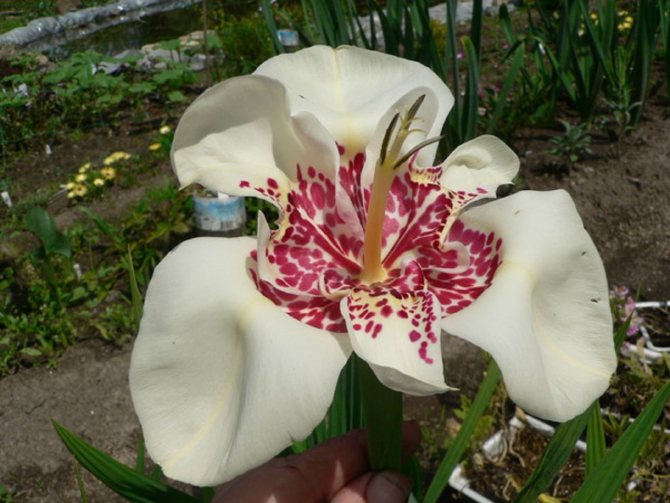

Preparing for landing
The seeds do not need to be prepared before planting, if only for rapid growth they can be soaked briefly in zircon. The bulbs also do not require any preliminary manipulations before planting in the ground.
A place
This is a sun-loving plant and when planted in shady places, the flower develops worse.In such areas, it loses its brightness, and the stems become thin and weak, after which they will have to be tied up. The site must be free of drafts.
Priming
The soil needs light, loose and breathable, where there is no constant moisture. The flower loves nutritious and fertilized soils with little peat content. In heavy soil, fertilizer and sand are added to it. If the soil is dense, it must be loosened by adding sawdust. Acidic soils are treated with a solution with the addition of lime.
Diseases, pests and possible complications
Problems in growing tigridia arise when the rules for caring for it are not followed and the rules for storing bulbs are violated. Waterlogged and poorly ventilated bulbs are affected by scab, rust, or viral mosaics. To prevent this from happening, you need to carefully control the level of soil moisture, loosen it. When signs of disease appear, the plants are treated with fungicides: Fundazol, Oxyhom.
Tigridia bulbs and shoots are affected by slugs, thrips and bear. To protect the planting material, it is recommended to treat the wells with insecticides before placing the bulbs in the soil. Pest baits are placed inside the hole and scattered around the stems.
Important. The fight against slugs and snails should be started immediately at the first sign of their appearance. Bulbs damaged by them are not suitable for winter storage!
Necessary plant care
The sophistication of a tigridia flower does not mean that the plant is capricious. But it requires timely watering with warm, settled water. It is necessary to water tigridia at the root, and irrigate superficially only in the hottest, driest periods.
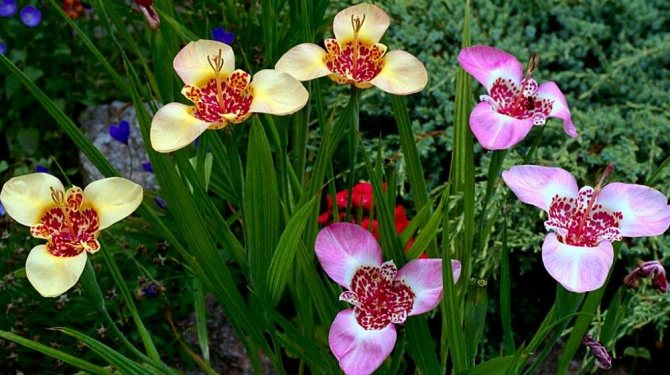

Water the tigridia with warm water
Twice during the growing season, tigridia needs to be fed:
- the first feeding is carried out immediately after the first shoots appear;
- the second - during the formation of buds.
For top dressing, any mixture of mineral fertilizers intended for flowering plants is used.
During the cultivation of tigridia, wilted buds and drying leaves must be removed in a timely manner. It is recommended to tie the stems of tall varieties to a peg installed next to the plant so that they do not break.
Towards the end of flowering, watering is sharply reduced to stimulate wilting of the aerial part and accelerate the ripening of the bulbs. If it rains in August-September, the tigridia is not watered. In too rainy periods, it is recommended to cover the ripening bulbs with foil so that they do not suffer from waterlogging.
Growing tigridia by seeds
Flower reproduction is possible in two ways. The first is sowing with seeds, the second with bulbs.
Planting tigridia with seeds is not difficult. With this method, tigridia begins to bloom quickly.
Sowing can be done before winter or early spring. The seeds germinate well enough.


Planting tigridia in the spring is carried out in pre-prepared containers, which are filled with soil.
You can cook it yourself or buy it on the market, in the store.
If you make the soil yourself, then you need to mix the garden soil with peat and sand. Next, they start sowing:
- Pour the nutritious soil mixture into containers, make depressions.
- The seeds are laid out in the pits. You do not need to deepen them.
- Sprinkle a little earth on top, watered.
In order not to plant the plants further, you can immediately leave a distance of at least 5 cm between the seeds.
Throughout the growth of seedlings, it must be watered regularly.
You can focus on the state of the soil mixture.
The plant can be transplanted into open ground no earlier than mid-May, since the tigridia loves warmth.
The timing is approximate, since the weather is different in different regions of the country.
That is why you need to look at the weather.
When it gets warm outside, there will be no frosts at night, you can start transplanting the plant to a permanent place.
Landing features
To ensure the full growth of the plant, spring planting should be carried out. In most cases, the bulbs are planted in the ground at the end of May. If the planting of the plant is carried out much earlier, then the florist needs to take care of the shelter during the frost.
Attention! It is not recommended to plant the bulbs during the summer, as this can lead to their drying out.
Before planting a plant in the spring, you need to choose the right place. It is best to plant the plant in a lighted place that is reliably protected from the wind. The cultivation of some plant species can be carried out in partial shade. During the period of planting the bulbs, it is necessary to ensure that the distance between them is at least 15 centimeters. The bulbs must be planted 10 centimeters deep.
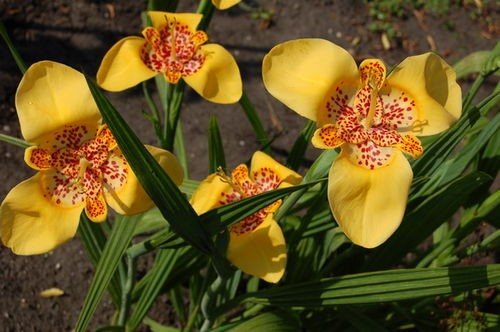

Peacock mix in the garden.
In order to speed up the flowering process of a plant at home, forcing is done. For this, the bulbs of the plant are placed in boxes with soil at the end of March. They must be germinated indoors. in the first two weeks, intensive watering of the bulbs is ensured. After the roots appear, this procedure is performed less frequently. In the month of May, the plant is planted in a flower bed.
Tigridia in landscape design
Designers advise placing tigridia groups away from other flowers. An unsuccessful tandem creates excessive variegation, although this is a matter of taste! In general, ground covers are considered the best neighbors, but again, it is better to choose the options yourself, the main thing is that the plants do not muffle each other.
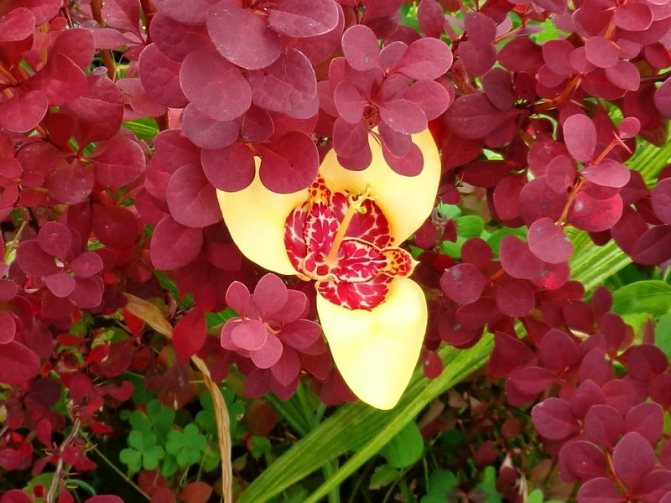

Tigridia look great against the background of a lawn, various conifers, shrubs or any stone structures. The islets of this flowering plant fit perfectly into the coastline of water bodies or near the borders.


Tigridia grows well in various containers, which means that flowers can be placed anywhere, for example, on an open terrace or near a pool, as long as the wind does not interfere with the plant in this place.


Here is such a very unpretentious tigridia - planting and caring for it in the open field is quite within the power of even novice gardeners. We have sheltered these beauties in street containers and have been admiring them for the third year already.
Types of tigridia
In domestic gardens, tigridia is represented by a modest assortment of varieties. The most popular are:
- Alba;
- Canaryensis;
- Auer;
- Lilacea.
Tigridia Alba - a variety with large white flowers, decorated with a variegated red center. The diameter of the opened bud varies within 15 cm.
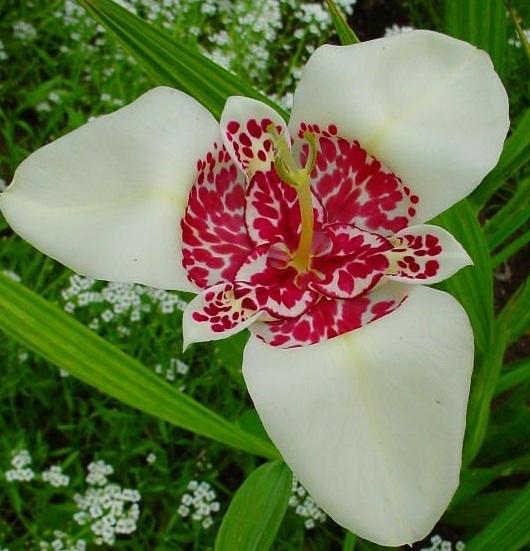

Tigridia Canaryensis - a plant with dull inflorescences of pastel shades. The center of the bud is bright red. The size of the inflorescence varies from 10 to 15 cm.


Tigridia Auer- the owner of bright yellow petals, framing a variegated core. The buds are large, up to 15 cm.
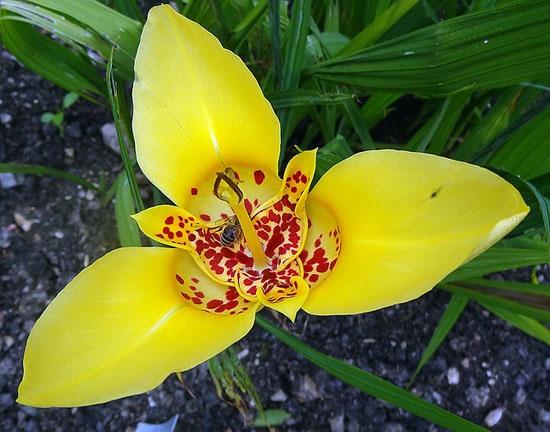

Tigridia lilacea - a variety with rose petals and a traditional patterned center of the bud. The size of the inflorescences exceeds the 10 cm mark.
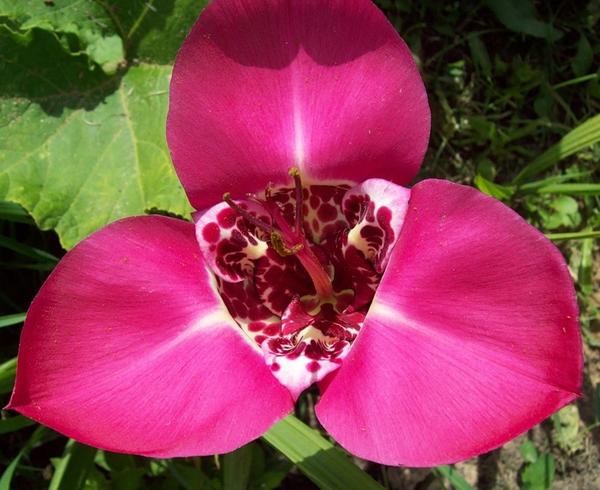

Flower propagation
As mentioned above, tigridia can be propagated by seeds or bulbs. When using seeds, it is not necessary to carry out direct sowing into the ground, but a seedling method of cultivation.
If you prefer to propagate the culture with bulbs, in the fall you need to dig up an adult plant by the root, and separate several children from the mother bulb, which will be used to cultivate new plants. In the future, it is enough to wrap the planting material in a damp cloth and put it on the lower shelf of the refrigerator. This way you can save it until the spring planting in the ground.
Seed planting
Since the seed method of propagation is considered more complicated than when growing a flower from bulbs, we will dwell on it in more detail. In a temperate climate, it makes no sense to sow seeds directly into the ground, since they will not have time to germinate and get stronger. Therefore, preference should be given to the seedling method (Figure 4).


Figure 4. Reproduction of the culture by seeds
For this, the seeds are sown in containers with light and loose soil and kept in a greenhouse or at home. In this case, the temperature should be high enough, of the order of +20 degrees, since the planting material of the culture is very sensitive to a decrease in temperature and may not germinate.
Note: It is advisable to fill containers for seedlings with light peat-sandy soil, and after planting the seeds, the soil is regularly moistened.
Seedlings appear amicably and relatively early - only 2-3 weeks after sowing. If the crops are too dense, it is advisable to dive them in separate pots so that the sprouts have time to get stronger before transplanting into the ground. Planting seedlings on a flower bed is carried out at the end of May. During the warm season, they will have time to form a strong bulb and become strong enough for wintering.
Sowing seeds
Tigridia seeds are distinguished by excellent germination. Therefore, it is not difficult to grow it in this way. You just need to correctly calculate the sowing time. With late spring planting, the bulbs will not have time to ripen before the cold weather. Therefore, the seedling method of growing is usually practiced. If you start sowing in winter, then before autumn the bulbs will get stronger and will be ready to release beautiful healthy flower stalks next season.
It is best to use a soil mixture with the addition of sand and a small amount of peat as a soil. Seeds should not be buried too deep. It is enough to cover them with a 2-3 mm layer of soil. The distance between adjacent seeds should be at least 5 cm. And it is better to place each plant individually. This will help to avoid additional transplants in the future.
With regular moistening, the first shoots will appear above the ground in 2-3 weeks. A month later, if necessary, they are seated in separate containers. Seedlings can be transferred to open ground at the end of spring, when the above zero temperature stabilizes.
How to dig up and store in winter
Preparation of culture for wintering is of great importance. The plant can bloom until frost, but in this case, the bulbs do not have time to accumulate useful substances for the next season. Therefore, a couple of weeks before the temperature drops, the peduncles should be cut off. When the leaves wither, the bulbs need to be dug up.
It is worth removing only part of the soil in order to avoid damage to the daughter growth. Within 1 month after digging, the bulbs are dried at room temperature. After 15-18 days, they get rid of the remnants of the earth, completely cut off the roots and remnants of greenery.
Dried bulbs should be stored in a cool, dry place. It is recommended to do this in a container with sand. In high humidity conditions, they must be placed in nets and hung.
Storage of planting material
Tigridia corms are dug at the end of September, when the foliage begins to turn yellow on the plant. It is important to remove the planting material from the ground very carefully so that the baby does not crumble from it. The stems must first be cut off, leaving only a small part of about 20 cm.
After removing from the ground, the corms should be prepared for storage. To do this, they need to be rinsed in water. You can also dip them in the Inta-Vir solution, but after that they need to be rinsed again under the tap. Then it is recommended to hold the planting material of tigridia in a weak solution of potassium permanganate for 15-20 minutes and leave to dry for a month. All the same procedures must be carried out with the child who has separated.
Bulbs should be stored completely dry. But before that, you need to remove the remaining parts of the stems. They can be simply cut with scissors or pruning shears. It is recommended to store corms at a temperature of 8-12 ° C. Some growers put them in dry peat. If it is not possible to place the planting material in the basement, then you can store it in the refrigerator in thick paper bags.
If you want to decorate your garden not only with tigridia, but also with other beautiful bulbs, take a look at the section of our forum dedicated to these cultures. We are sure you will have something to discuss with other growers!
>



